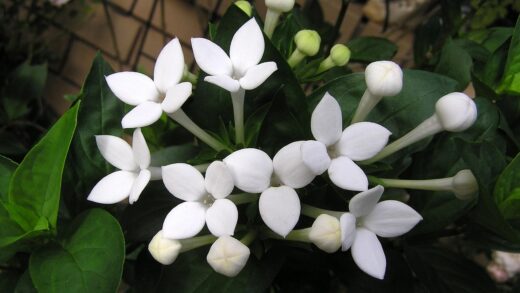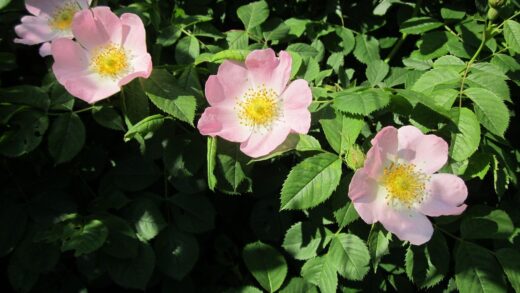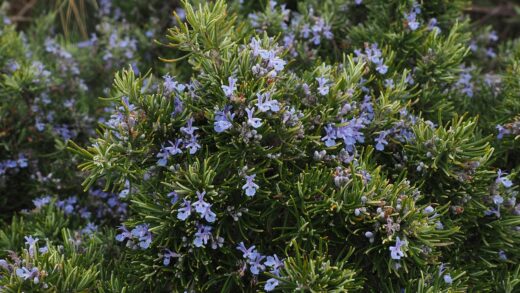The provision of appropriate light is a cornerstone of successfully cultivating Hypericum androsaemum, as it directly governs the plant’s ability to photosynthesize, produce energy, and carry out its vital functions. While this shrub is celebrated for its adaptability, its true ornamental potential—characterized by dense foliage, a profusion of bright yellow flowers, and a rich crop of colorful berries—is only fully realized when its light requirements are met. Understanding the ideal balance between sun and shade is therefore not just a technical detail but a fundamental aspect of enabling the plant to thrive. A carefully chosen location that respects its relationship with the sun will result in a healthier, more vibrant, and more resilient garden specimen.
This particular species has evolved in habitats such as woodland clearings and hedgerows, environments that are typically characterized by dappled sunlight or a mix of sun and shade throughout the day. This natural history provides a significant clue to its preferences in a garden setting. It is not a plant that demands the relentless, baking sun of a south-facing wall, nor is it one that will flourish in the deep, perpetual gloom of a north-facing aspect or under the dense canopy of large trees. Its ideal environment is one that mimics the bright, filtered light of a woodland edge.
The process of photosynthesis, which is the mechanism by which plants convert light energy into chemical energy to fuel their growth, is directly proportional to the amount of light they receive. For Hypericum androsaemum, sufficient light is the trigger for robust flowering. A plant that receives adequate sunlight will produce a significantly greater number of flowers compared to one grown in heavy shade. Since the decorative berries develop from these flowers, a good floral display is a prerequisite for the much-admired autumn and winter interest provided by the fruit.
The quality of the foliage is also directly impacted by the light conditions. In a location with a good amount of light, the leaves will be a rich, healthy green, and the overall habit of the shrub will be dense and compact. In contrast, a plant struggling in too much shade will often become etiolated, a condition where the stems stretch and become long, weak, and “leggy” as the plant reaches for more light. The foliage in such conditions may be larger but thinner and a paler shade of green, and the entire shrub will have a more sparse and open appearance.
The importance of light for photosynthesis and flowering
Photosynthesis is the single most important biological process for plants, and light is its essential ingredient. Within the plant’s leaves, chlorophyll absorbs energy from sunlight, which is then used to convert carbon dioxide and water into glucose, the sugar that provides energy for all of the plant’s activities, from producing new leaves to defending against pests. Without sufficient light, this energy production line slows down, resulting in a plant with reduced vigor and poor overall health. Every aspect of the plant’s growth is fundamentally tied to the efficiency of this process.
More articles on this topic
For flowering plants like Hypericum androsaemum, the energy generated through photosynthesis is not only used for vegetative growth but is also critically invested in the production of flowers. Flowering is an energy-intensive process, and a plant will only initiate it when it has accumulated sufficient energy reserves. This is why light levels have such a direct and dramatic effect on the quantity of blooms. A location that provides several hours of direct sunlight each day ensures the plant can produce the surplus energy required to support a prolific flowering display.
The duration and intensity of light also play a role. The long days and high light intensity of late spring and early summer act as environmental cues that stimulate the plant to enter its flowering phase. The bright, open-faced yellow flowers are also designed to be visible to pollinators, and placing the shrub in a reasonably sunny spot makes it more apparent to bees and other insects, which can lead to more successful pollination. This, in turn, is necessary for the development of the ornamental berries that follow the flowers.
Consequently, when selecting a planting site, light availability should be a primary consideration if a strong floral and fruit display is desired. While the plant will survive in considerable shade, its performance will be a pale imitation of its potential. The difference between a shrub that produces a handful of flowers and one that is covered in them can almost always be attributed to the amount of light it receives. Prioritizing a location with at least partial sun is the key to unlocking the full ornamental cycle of this versatile shrub.
Finding the optimal balance of sun and shade
The concept of “partial shade” or “partial sun” is often the ideal for Hypericum androsaemum, but these terms can be ambiguous. A more precise definition would be a location that receives approximately four to six hours of direct sunlight per day. The timing of this sun exposure is also important. Morning sun is generally considered the most beneficial, as it is less intense and allows the foliage to dry quickly from any overnight dew, which helps to prevent fungal diseases. Protection from the harsh, scorching sun of late afternoon, especially in hotter climates, can be advantageous.
More articles on this topic
A position on the east side of a building or a tall hedge is often perfect, as it will receive direct sun throughout the morning hours and then be in shade during the hottest part of the day. Another excellent location is in a woodland garden setting, situated beneath high-canopy deciduous trees. In such a spot, the plant will receive dappled sunlight throughout the day, and in the early spring, before the trees have fully leafed out, it will receive even more direct light to fuel its initial growth.
Observing the path of the sun across the intended planting area at different times of the day and in different seasons is an invaluable exercise. What appears to be a sunny spot in early spring may become quite shady once nearby deciduous trees are in full leaf. Conversely, an area that seems shady in the morning may receive intense sun in the afternoon. This careful observation before planting can prevent the need to transplant a poorly sited shrub later on.
The plant itself can provide feedback on its light conditions. If it is receiving the right amount of light, it will exhibit a compact growth habit, have vibrant green foliage, and will flower and fruit well. If the leaves appear scorched, bleached, or have brown, crispy edges, it may be receiving too much intense, direct sunlight. If the plant is tall and spindly with sparse foliage and few flowers, it is a clear indication that it needs a sunnier location. Learning to interpret these visual cues allows for adjustments to be made to ensure the plant’s long-term satisfaction.
Symptoms of inadequate or excessive light exposure
Inadequate light is one of the most common reasons for the poor performance of Hypericum androsaemum in a garden setting. The most obvious symptom is a significant reduction in, or complete lack of, flowering. The plant, lacking the energy to reproduce, will prioritize its survival by putting what little energy it can generate into vegetative growth. This growth, however, will be weak. The stems will be elongated and thin as the plant stretches towards the nearest light source, a phenomenon known as etiolation.
The foliage of a light-deprived shrub will also show distinct signs. The leaves may be larger than normal but will be a paler shade of green due to lower concentrations of chlorophyll. The overall density of the shrub will be poor, giving it a sparse, open, and unattractive appearance. A plant in deep shade is also often more susceptible to fungal diseases, as the lack of direct sun and poor air circulation mean the foliage stays damp for longer periods, creating an ideal environment for pathogens like rust and leaf spot to thrive.
On the other end of the spectrum, excessive light exposure can also cause problems, particularly for plants sited in hot, dry, and exposed locations. The most common symptom of too much sun is leaf scorch. This appears as brown, dry, and crispy patches on the leaves, especially around the margins. In very intense sun, the foliage can take on a bleached or washed-out, yellowish appearance. The plant may also show signs of wilting during the hottest part of the day, even if the soil is moist, as the leaves lose water through transpiration faster than the roots can absorb it.
A plant under stress from excessive sun may also experience stunted growth. Although it is receiving ample light for photosynthesis, the heat and water stress that often accompany a hot, sunny position can inhibit its ability to grow effectively. The flowers may fade more quickly than they would in a more protected location, and the overall health of the plant can be compromised, making it more vulnerable to pests like spider mites, which thrive in hot, dry conditions. Finding that middle ground of bright but not baking light is the key to avoiding both of these extremes.
Adapting to different light conditions in the garden
While there is an ideal set of light conditions for Hypericum androsaemum, gardeners often have to work with the existing light patterns in their landscape. Fortunately, this plant’s adaptability allows for some flexibility. If the only available spot is in full, all-day sun, it is possible to compensate for the added stress this creates. The key is to provide consistently moist soil through regular watering and the application of a thick layer of organic mulch. The mulch will help to keep the root zone cool and reduce water evaporation from the soil surface.
In a situation where the garden is predominantly shady, it is still possible to grow this shrub, although expectations for its performance must be adjusted. It may not flower as prolifically, but it can still function as an attractive foliage plant, providing texture and a splash of green in a shaded border. To maximize its chances, it is important to provide the brightest possible shade, such as the dappled light under tall trees, rather than the dense, dark shade next to a wall. Improving the soil with plenty of organic matter can also help to boost the plant’s overall vigor.
For plants grown in containers, the gardener has the ultimate control over light conditions. The pot can be moved throughout the day or throughout the season to provide the optimal amount of sun. For example, a container could be placed in a sunny position in the spring to encourage strong growth and flower bud formation, and then moved to a location with some afternoon shade during the peak of summer to prevent scorching. This mobility is a significant advantage of container gardening.
Sometimes, the light conditions in a garden change over time. A newly planted tree may grow to cast shade over a formerly sunny spot, or the removal of a large shrub might suddenly expose a shaded area to full sun. It is important to periodically reassess the light conditions in the garden and be prepared to move a plant if its location is no longer suitable. Hypericum androsaemum transplants reasonably well, especially if moved in the autumn or early spring during its dormant period, allowing it to continue to thrive even as the garden around it evolves.


















